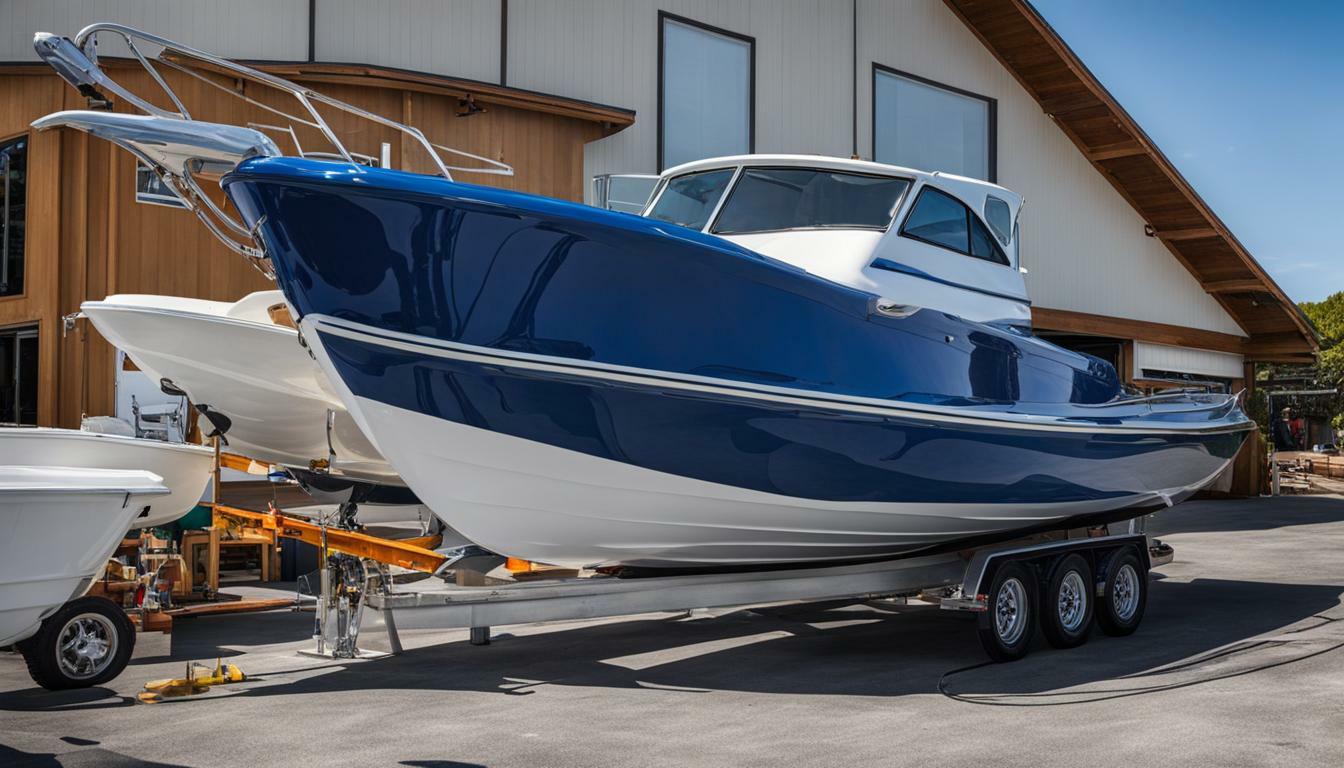Painting a fiberglass boat can breathe new life into its appearance and increase its value. While it may take some time and effort, doing it yourself can save you money compared to hiring a professional. In this guide, we will provide you with detailed information on how to paint a fiberglass boat efficiently, from preparation to the final steps.
Key Takeaways:
- Proper preparation is crucial before painting a fiberglass boat.
- Choosing the right paint can make a significant difference in the final result.
- Protecting the drying paint is essential to ensure a flawless finish.
Preparing the Boat Surface
Preparation is the most crucial part of the painting job. Start by thoroughly cleaning the boat using a high-pressure hose, rags, and a scraper. Rinse the boat thoroughly after cleaning, making sure to remove any soap residue. Also, remove all hardware or cover it with painter’s tape to protect it.
Before painting, it is essential to remove the wax coating from the boat’s surface using a solvent. A waxy finish will prevent the paint from sticking properly. If there are any cracks, nicks, or corrosion on the boat’s surface, repair them using a marine-grade epoxy. Sand the boat’s surface with 80-grit sandpaper to ensure that all the old paint is removed.
During the preparation process, you should inspect every inch of the boat’s surface. Ensure to check for any signs of blisters or other defects that could impact the paint’s adhesion. It is also essential to check for moisture in the laminate, which can cause the paint to peel. If you discover any of these defects, repair them before continuing with the painting process.
When you are confident that the boat’s surface is clean and smooth, the painting process can begin. Proper preparation will ensure that the paint adheres correctly, ensuring a long-lasting and beautiful finish.
Surface Repair and Sanding
Before painting, it is essential to remove the wax coating from the boat’s surface using a solvent. A waxy finish will prevent the paint from sticking properly. If there are any cracks, nicks, or corrosion on the boat’s surface, repair them using a marine-grade epoxy.
Once any damages are repaired, sanding the boat’s surface with 80-grit sandpaper helps ensure that all the old paint is removed. Use a sanding block to keep the sandpaper flat and avoid causing any uneven spots.
After sanding, clean the boat thoroughly with soap and water to remove any remaining dust or debris. Rinse the boat with a hose and let it dry completely before proceeding to the next step.
Applying Primer
When it comes to painting the boat, the first step is using a primer. While not necessary for fiberglass boats, using a compatible primer can enhance the paint’s durability and adhesion. It will also help the paint stick to the boat’s surface properly, preventing any chipping or peeling in the future.
Using a roller or brush, apply one layer of primer to the boat’s surface. Make sure to cover all areas, including corners and hard-to-reach spots. Once the first layer is dry, lightly sand the boat’s surface with 300-grit sandpaper before applying the next coat. This will remove any rough spots and ensure a smooth finish.
Depending on the type of primer used, you may need to wait a certain amount of time before applying the next coat. Check the manufacturer’s instructions for guidance on drying times.
For best results, it’s recommended to apply at least two coats of primer to the boat’s surface. Once you’ve finished applying the primer, wait for one to two hours before removing any tape and applying the first layer of paint.
Choosing the Right Paint
When choosing the paint, there are various options available. For fiberglass boats, one-part polyurethane paints and two-part polyurethane paints are commonly used. One-part polyurethane paints can be rolled and tipped, while two-part polyurethane paints offer durability and gloss retention. Alkyd enamel is another option and is easier to apply with a brush.
One-part polyurethane paints are a good choice for those who want a DIY-friendly application. They are self-leveling and can be applied with a foam roller or brush, making them ideal for people who are new to boat painting. However, they are not as durable as two-part polyurethane paints and may require yearly touch-ups.
If you are looking for a more durable option, two-part polyurethane paints offer better adhesion and a higher gloss finish. These paints require careful preparation, including mixing the two-part solution and applying with a spray gun to ensure an even finish. They can be more expensive than one-part polyurethane paints, but they offer better value in the long term.
Alkyd enamel is a third option that is easier to apply with a brush. It is less expensive than polyurethane paint but does not offer the same level of protection. Alkyd enamel is a good choice for those who want a budget-friendly option but are willing to compromise on durability.
Whichever type of paint you choose, make sure to follow the manufacturer’s instructions carefully for the best results. Choosing the right paint is crucial for a successful fiberglass boat paint job.
Applying the Paint
Mix the paint according to the manufacturer’s instructions and apply the first layer using a paint roller or brush. If using a two-part polyurethane paint, apply it in smaller sections to ensure even application. Take your time while applying the paint, and avoid rushing or over-brushing. If the paint is too thick, thin it with the manufacturer’s recommended thinner.
Start by painting the top of the boat, working your way down. Apply the paint in long, even strokes, and avoid going over the same area more than once. Use a detail brush to reach any hard-to-reach corners and edges. Once the first coat has dried, lightly sand the surface with a fine-grit sandpaper before applying the second coat.
For optimal results, repeat this process until you have at least two coats of paint. Always wait for the paint to dry between coats and avoid painting in humid or damp conditions.
Additional Fiberglass Boat Painting Tips
- Work in a well-ventilated area and wear protective gear, including gloves, a respirator, and safety goggles.
- Use a paint strainer to remove any impurities and debris from the paint before application.
- Avoid painting in direct sunlight, as this can cause the paint to dry too quickly and result in uneven application.
- Practice good paintbrush and roller hygiene by cleaning your tools between coats and using them only for the same type of paint.
By following these tips and guidelines, you can achieve a professional-looking finish and prolong the life of your fiberglass boat’s paint job.
Drying and Protecting the Paint
Once the painting is complete, it is crucial to protect the drying paint from bugs and debris. Allow the paint to dry completely according to the manufacturer’s guidelines. To prevent insects and debris from sticking to the paint, cover it with a tarp or plastic sheeting while it dries.
Depending on the type of paint used, you may need to wait 24 hours to walk on the paint and up to five days before exposing it to cleaning agents. It is also important to avoid placing any heavy objects on the boat while the paint is drying, as this can cause indentations or damage to the surface.
After the paint has completely dried, remove the tarp or plastic sheeting carefully to avoid scratching the surface. Inspect the paint for any imperfections or areas that need touching up.
To maintain the appearance of the painted surface, regularly clean the boat after use with a gentle soap and water solution. Avoid using harsh chemicals or abrasive materials that can damage the paint. To protect the paint from harsh winter weather, consider storing the boat indoors or under a protective cover.
By taking these steps to protect the painted surface, you can ensure that your fiberglass boat looks great for many years to come. Regular maintenance and care will help extend the life of the paint and keep your boat looking new.
Maintenance Tips for Painted Fiberglass Boats
To maintain the paint’s appearance for years to come, always clean the boat thoroughly after use and protect it from harsh winter conditions and ice. These maintenance tips will help keep your boat looking great and protect the paint from damage.
First, rinse the boat with fresh water after each use, especially if used in saltwater. This will remove salt residue and prevent corrosion and rust. Use a soft-bristled brush or sponge and mild detergent to clean the boat’s surface. Avoid using harsh cleaning agents or scrubbing too hard, as this can damage the paint.
When storing the boat, choose a covered area that provides protection from extreme temperatures, UV rays, and precipitation. Consider using a boat cover to provide additional protection.
Regular waxing can also help protect the paint from damage. Choose a high-quality marine wax and apply it to the boat’s surface every six months. This will help maintain the paint’s shine and prevent fading or discoloration.
If you notice any damage to the painted surface, address it immediately to prevent further damage. Use touch-up paint or apply a new coat of paint if necessary.
By following these maintenance tips, you can protect the appearance and value of your painted fiberglass boat for years to come. With proper care and attention, your boat will continue to look great and provide hours of enjoyment on the water.
Conclusion
In conclusion, painting a fiberglass boat can be a rewarding and cost-effective DIY project. By following the proper preparation steps, choosing the right paint, and applying it correctly, you can master the art of painting a fiberglass boat efficiently. With the right equipment and care, your boat will have a new lease of life and increased value.
Preparation is key, starting with cleaning the boat’s surface and removing any wax coatings, followed by repairing any damages and sanding the surface. Applying a primer and choosing the right paint can help ensure durability and a glossy finish. Protecting the drying paint and maintaining it regularly can help prolong the paint’s appearance for years to come.
Remember to take the necessary safety precautions when working with paint and be sure to follow the manufacturer’s instructions at all times. With time and effort, you can achieve a beautiful finish that will make your boat look as good as new.
So why not start your boat renovation journey today and give your fiberglass boat a much-needed makeover? You’ll be amazed at the difference it can make!
FAQ
Q: How long does it take to paint a fiberglass boat?
A: The time required to paint a fiberglass boat can vary depending on the size of the boat and the level of preparation needed. On average, it can take several days to complete the entire process.
Q: Do I need to remove all the hardware before painting?
A: It is recommended to either remove the hardware or cover it with painter’s tape to protect it from paint splatters or damage.
Q: Can I use regular paint on a fiberglass boat?
A: Regular paint may not adhere properly to the fiberglass surface and may not provide the same level of durability or gloss retention. It is recommended to use marine-grade paints specifically designed for fiberglass boats.
Q: How long should I wait before applying the second coat of paint?
A: It is recommended to wait for one to two hours after applying the first coat before removing any tape and applying the second coat. However, always refer to the manufacturer’s guidelines for the specific paint being used.
Q: How long does the paint take to dry?
A: The drying time can vary depending on the type of paint used. In general, you may need to wait 24 hours before walking on the paint and up to five days before exposing it to cleaning agents.
Q: How often should I clean my painted fiberglass boat?
A: It is important to clean your boat thoroughly after each use to remove dirt, salt, and other debris that can degrade the paint’s appearance over time. Regular cleaning and maintenance will help prolong the life of the paint job.



